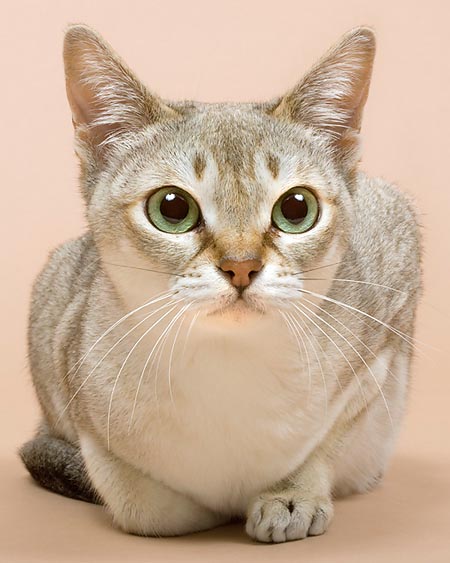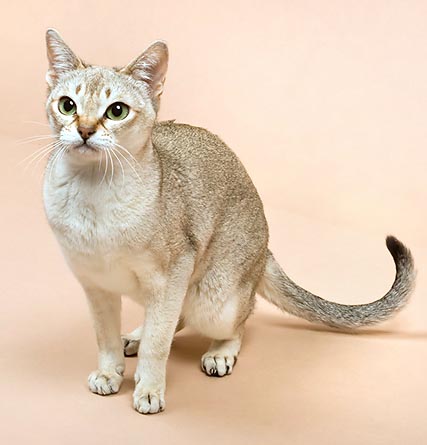Family : Felidae

Text © Dr Didier Hallépée

English translation by Mario Beltramini

The Singapura is affectionate and looks for the human contact © G. Mazza
After the legend, the Singapura is a natural adaptation of the domestic cats to the life conditions in the roads of Singapore (city of the lion). Their small size should come from their habitat, the sewers of Singapore, where conduits are small.
The first three specimens were carried from Singapore by Tommy and Hal Meadow in 1975. In1981, another lover brought, he too, a specimen from Singapore, which was included into the breeding programme.
It would seem, however, that these first three cats, small by chance, have come out from crossings between Abyssinians and Burmese and have accompanied Tommy and Hal Meadow in 1974 for their stay in Singapore, before reaching USA with them. The utilization of the Burmese is proved by genetic studies. But, as the movie “The man who shot Liberty Valance” says: “When the legend is more beautiful than the reality, print the legend”.
The Singapure has been recognized as a breed in 1982, and, following this recognition, the Singapore Tourist and Promotion Board (STPB) has adopted the Singapura as a touristic mascot under the name of “kucinta” (from the Malaysian “kucing” = cat, and “cinta” = love). The exportations of the cats of Singapore are presently under control.
Character
The Singapura is active, curious and playful. Affectionate, seeks the human contact. The Singapura is the smallest domestic cat.
Standard
Rounded and quite small, the head has, seen from the front, a rounded skull prolonged by high and broad cheek-bones. By profile, the front is slightly bulged and followed by a hollow slope at the beginning of the nose. This one, rather short, is slightly bulged. Of medium length, the muzzle is broad and delimited by a well defined pinch. It must be neither sharp nor narrow. The chin is firm and well developed.
Big and much expressive, the eyes are wide open and nut-shaped. Even if well spaced of at least the width of one eye, they must be neither rounded nor protuberant. The green in all its nuances is the preferred colour, provided they are uniform. The blue colour is not accepted.

The Singapura is the smallest domestic cat © Giuseppe Mazza
Big, attentive and moderately sharp, the ears are shaped like a cup with a well bell-shaped base. This open base is particularly important in the general impression of greatness of the ears. They are spaced of the width of one ear. The interior of the ears is well hairy.
The short neckline is thick. Of semi-cobby format, it has a compact body with a well open and rounded thorax.
The paws, strong and thick at their beginning, get thinner up to a rather thin bone-frame. The feet are small, oval and firm. Ideally long enough for reaching the scapula, the tail, slightly dense at the base, gets thinner up to a rounded tip.
Fine, silky and without down-hair, the fur is well laying on the body. Short, it must anyway have a sufficient length in way that each hair can have several alternated bands, pale and dark, called ticking. It is longer on the spine. The kittens may have a longer and woollier fur than the adults.
Coat
The bottom of the hair is of old ivory colour. The ticking, the maquillage marks, the pads, and the extremity of the tail are dark brown or black. The truffle, of brick colour, is delimited by a dark brown or black edge.
The pattern is genetically ticked tabby sepia, that is, each hair has an alternation of at least four ivory and dark brown or black bands, but the whisker pads, the throat, the chest, the belly, the inner part of the paws and the lower side of the tail which are not speckled.
The ticking is more evident on the backbone and on the tail. The base of the hair is always pale and the extremity dark. The fore side of the fore limbs and the knees must ideally have tabby marks. The head has they typical patterns of the tabby cats: inverted M on the front, slight maquillage marks around the eyes and on the cheeks.
→ For general notions about Felidae please click here.
→ To appreciate the biodiversity within the CAT BREEDS please click here.
